The Effect of POFA-Gypsum Binary Mixture Replacement on the Performance of Mechanical and Microstructural Properties Enhancements of Clays
Abstract
:1. Introduction
2. Theoretical Background
3. Materials and Design
Test Preparation and Procedures
4. Results and Discussion
4.1. Optimum Water Content and Maximum Dry Density
4.2. Stress–Strain Curve of Unconfined Compression Test
4.3. Shear Strength with Percentages of the Stabilizing Agents
4.4. Shear Strength with Curing Period
4.5. Microstructural Imaging
5. Conclusions
- -
- The reduction of MDD during soil stabilization is about 10%, which is referred to due to the compaction resistance caused by the flocculation of mixture particles.
- -
- In the case when POFA is used as a stabilizing agent with gypsum, it is found that the density of soft clay is affected by lime content, existing in gypsum, where the lime has the tendency to absorb more water and hence decrease the MDD of treated soil.
- -
- The increment of the strength with the mixture of gypsum and POFA is also predicted to double compared to the control sample due to soil susceptibility to water content variation reduction. This is followed by agglomeration and flocculation of soil particles.
- -
- Utilizing gypsum as a cementation agent may enhance clay particle aggregation, which led to an increase in shear strength and cohesion on synthetic gypsum and POFA for stabilizing clay.
- -
- As gypsum contains a high amount of lime (CaO), the results illustrate that the strength is raised significantly, even with less curing time due to its high reactivity compared to silica and alumina.
- -
- POFA–gypsum mixture appears to have some irregular and spherical-shaped particles with sharp angles, fewer voids, and an apparent enhancement of hydration products.
- -
- Overall, no hydration has occurred for the control sample where voids are easily recognized and distinguished, where the treated sample clearly showed hydration products.
Author Contributions
Funding
Institutional Review Board Statement
Informed Consent Statement
Data Availability Statement
Acknowledgments
Conflicts of Interest
References
- Mohn, D.; Cutright, D.T.J.; Abbas, D.A.; Senko, D.J.M. Impact of Gypsum Bearing Water on Soil Subgrades Stabilized with Lime or Portland Cement. Ph.D. Thesis, The Graduate Faculty of the University of Akron, Akron, OH, USA, 2015. [Google Scholar]
- Yilmaz, I.; Civelekoglu, B. Gypsum: An additive for stabilization of swelling clay soils. Appl. Clay Sci. 2009, 44, 166–172. [Google Scholar] [CrossRef]
- Marto, A.; Hassan, M.A.; Makhtar, A.M.; Othman, B.A.; Ash, B.C.; Marto, A.; Hassan, M.A.; Makhtar, A.M.; Othman, B.A. Shear Strength Improvement of Soft Clay Mixed with Tanjung Bin Coal Ash. APCBEE Procedia 2013, 5, 116–122. [Google Scholar] [CrossRef] [Green Version]
- Saeed, A.H.K.; Kassim, K.A.; Yunus, N.Z.M.; Nur, H.; Abdul Hussein Saeed, K.; Kassim, K.A.; Mohd Yunus, N.Z.; Nur, H. Physico-Chemical Characterization Of Lime Stabilized Tropical Kaolin Clay. J. Teknol. 2015, 72, 83–90. [Google Scholar] [CrossRef] [Green Version]
- Behnood, A. Soil and clay stabilization with calcium- and non-calcium-based additives: A state-of-the-art review of challenges, approaches and techniques. Transp. Geotech. 2018, 17, 14–32. [Google Scholar] [CrossRef]
- Firoozi, A.A.; Guney Olgun, C.; Firoozi, A.A.; Baghini, M.S. Fundamentals of soil stabilization. Int. J. Geo-Eng. 2017, 8, 26. [Google Scholar] [CrossRef] [Green Version]
- Al-Hokabi, A.; Hasan, M.; Amran, M.; Fediuk, R.; Vatin, N.I.; Klyuev, S. Improving the early properties of treated soft kaolin clay with palm oil fuel ash and gypsum. Sustainability 2021, 13, 10910. [Google Scholar] [CrossRef]
- Onaizi, A.M.; Lim, N.H.A.S.; Huseien, G.F.; Amran, M.; Ma, C.K. Effect of the addition of nano glass powder on the compressive strength of high volume fly ash modified concrete. Mater. Today Proc. 2021, 48, 1789–1795. [Google Scholar] [CrossRef]
- Haruna, S.; Mohammed, B.S.; Wahab, M.M.A.; Kankia, M.U.; Amran, M.; Gora, A.M. Long-Term Strength Development of Fly Ash-Based One-Part Alkali-Activated Binders. Materials 2021, 14, 4160. [Google Scholar] [CrossRef]
- Amran, M.; Debbarma, S.; Ozbakkaloglu, T. Fly ash-based eco-friendly geopolymer concrete: A critical review of the long-term durability properties. Constr. Build. Mater. 2021, 270, 121857. [Google Scholar] [CrossRef]
- Amran, Y.H.M.; Soto, M.G.; Alyousef, R.; El-Zeadani, M.; Alabduljabbar, H.; Aune, V. Performance investigation of high-proportion Saudi-fly-ash-based concrete. Results Eng. 2020, 6, 100118. [Google Scholar] [CrossRef]
- Loganina, V.; Sergeeva, K.; Fediuk, R.; Uvarov, V.; Vatin, N.; Vasilev, Y.; Amran, M.; Szelag, M. Increase the performances of lime finishing mixes due to modification with calcium silicate hydrates. Crystals 2021, 11, 399. [Google Scholar] [CrossRef]
- Mosaberpanah, M.A.; Amran, Y.H.M.; Akoush, A. Performance investigation of palm kernel shell ash in high strength concrete production. Comput. Concr. 2020, 26, 577–585. [Google Scholar] [CrossRef]
- Avudaiappan, S.; Prakatanoju, S.; Amran, M.; Aepuru, R.; Saavedra Flores, E.I.; Das, R.; Gupta, R.; Fediuk, R.; Vatin, N. Experimental Investigation and Image Processing to Predict the Properties of Concrete with the Addition of Nano Silica and Rice Husk Ash. Crystals 2021, 11, 1230. [Google Scholar] [CrossRef]
- Muthalvan, R.S.; Ravikumar, S.; Avudaiappan, S.; Amran, M.; Aepuru, R.; Vatin, N.; Fediuk, R. The Effect of Superabsorbent Polymer and Nano-Silica on the Properties of Blended Cement. Crystals 2021, 11, 1394. [Google Scholar] [CrossRef]
- Khalid, N.; Mukri, M.; Kamarudin, F.; Sidek, N.; Arshad, M.F. Strength of Soft Soil Stabilized Using Lime-POFA Mixtures. In InCIEC 2013; Springer: Singapore, 2014; pp. 501–510. ISBN 9789814585026. [Google Scholar]
- Makusa, G.P. Soil Stabilization Methods and Materials in Engineering Practice; Luleå University of Technology: Luleå, Sweden, 2012. [Google Scholar]
- Fondjo, A.A.; Theron, E.; Ray, R.P. Stabilization of Expansive Soils Using Mechanical and Chemical Methods: A Comprehensive Review. Civ. Eng. Archit. 2021, 9, 1295–1308. [Google Scholar] [CrossRef]
- Siddika, A.; Al Mamun, M.A.; Alyousef, R.; Amran, Y.H.M.; Aslani, F.; Alabduljabbar, H. Properties and utilizations of waste tire rubber in concrete: A review. Constr. Build. Mater. 2019, 224, 711–731. [Google Scholar] [CrossRef]
- Lesovik, V.; Volodchenko, A.; Fediuk, R.; Mugahed Amran, Y.H.; Timokhin, R. Enhancing performances of clay masonry materials based on nanosize mine waste. Constr. Build. Mater. 2021, 269, 121333. [Google Scholar] [CrossRef]
- Tolstoy, A.; Lesovik, V.; Fediuk, R.; Amran, M.; Gunasekaran, M.; Vatin, N.; Vasilev, Y. Production of greener high-strength concrete using russian quartz sandstone mine waste aggregates. Materials 2020, 13, 5575. [Google Scholar] [CrossRef]
- Lesovik, V.; Volodchenko, A.; Fediuk, R.; Mugahed Amran, Y.H. Improving the Hardened Properties of Nonautoclaved Silicate Materials Using Nanodispersed Mine Waste. J. Mater. Civ. Eng. 2021, 33, 4021214. [Google Scholar] [CrossRef]
- Petropavlovskii, K.; Novichenkova, T.; Petropavlovskaya, V.; Sulman, M.; Fediuk, R.; Amran, M. Faience waste for the production of wall products. Materials 2021, 14, 6677. [Google Scholar] [CrossRef]
- Amran, M.; Fediuk, R.; Murali, G.; Avudaiappan, S.; Ozbakkaloglu, T.; Vatin, N.; Karelina, M.; Klyuev, S.; Gholampour, A. Fly ash-based eco-efficient concretes: A comprehensive review of the short-term properties. Materials 2021, 14, 4264. [Google Scholar] [CrossRef] [PubMed]
- Jafer, H.M.; Atherton, W.; Sadique, M.; Ruddock, F.; Loffill, E. Development of a new ternary blended cementitious binder produced from waste materials for use in soft soil stabilisation. J. Clean. Prod. 2018, 172, 516–528. [Google Scholar] [CrossRef]
- Amran, M.; Fediuk, R.; Murali, G.; Vatin, N.; Karelina, M.; Ozbakkaloglu, T.; Krishna, R.S.; Kumar, A.S.; Kumar, D.S.; Mishra, J. Rice husk ash-based concrete composites: A critical review of their properties and applications. Crystals 2021, 11, 168. [Google Scholar] [CrossRef]
- Siddika, A.; Amin, M.R.; Rayhan, M.A.; Islam, M.S.; Al Mamun, M.A.; Alyousef, R.; Mugahed Amran, Y.H. Performance of sustainable green concrete incorporated with fly ash, rice husk ash, and stone dust. Acta Polytech. 2021, 61, 279–291. [Google Scholar] [CrossRef]
- Zhang, T.; Yang, Y.L.; Liu, S.Y. Application of biomass by-product lignin stabilized soils as sustainable Geomaterials: A review. Sci. Total Environ. 2020, 728, 138830. [Google Scholar] [CrossRef] [PubMed]
- Onoja, E.; Chandren, S.; Abdul Razak, F.I.; Mahat, N.A.; Wahab, R.A. Oil Palm (Elaeis guineensis) Biomass in Malaysia: The Present and Future Prospects. Waste Biomass Valorization 2019, 10, 2099–2117. [Google Scholar] [CrossRef]
- Kamalrudin, M.; Abdullah, R. Malaysia-Moving Ahead to Sustainable Production Growth. Malays. Palm Oil Board 2014, 14, 10. [Google Scholar]
- Pourakbar, S.; Asadi, A.; Huat, B.B.K.; Fasihnikoutalab, M.H. Soil stabilisation with alkali-activated agro-waste. Environ. Geotech. 2015, 2, 359–370. [Google Scholar] [CrossRef]
- Aprianti, E. Effect of Curing Condition on the Characteristics of Mortar Containing High Volume Supplementary Cementitious Materials. Ph.D. Thesis, University of Malaya, Kuala Lumpur, Malaysia, 2017. [Google Scholar]
- Amran, M.; Murali, G.; Fediuk, R.; Vatin, N.; Vasilev, Y.; Abdelgader, H. Palm oil fuel ash-based eco-efficient concrete: A critical review of the short-term properties. Materials 2021, 14, 332. [Google Scholar] [CrossRef]
- Amran, M.; Lee, Y.H.; Fediuk, R.; Murali, G.; Mosaberpanah, M.A.; Ozbakkaloglu, T.; Lee, Y.Y.; Vatin, N.; Klyuev, S.; Karelia, M. Palm Oil Fuel Ash-Based Eco-Friendly Concrete Composite: A Critical Review of the Long-Term Properties. Materials 2021, 14, 7074. [Google Scholar] [CrossRef]
- Zeyad, A.M.; Johari, M.A.M.; Alharbi, Y.R.; Abadel, A.A.; Amran, Y.H.M.; Tayeh, B.A.; Abutaleb, A. Influence of steam curing regimes on the properties of ultrafine POFA-based high-strength green concrete. J. Build. Eng. 2021, 38, 102204. [Google Scholar] [CrossRef]
- Alrshoudi, F.; Mohammadhosseini, H.; Tahir, M.M.; Alyousef, R.; Alghamdi, H.; Alharbi, Y.; Alsaif, A. Drying shrinkage and creep properties of prepacked aggregate concrete reinforced with waste polypropylene fibers. J. Build. Eng. 2020, 32, 101522. [Google Scholar] [CrossRef]
- Tambichik, M.A.; Samad, A.A.A.; Mohamad, N.; Ali, A.Z.M.; Mydin, M.A.O.; Bosro, M.Z.M.; Iman, M.A. Effect of combining Palm Oil Fuel Ash (POFA) and Rice Husk Ash (RHA) as partial cement replacement to the compressive strength of concrete. Int. J. Integr. Eng. 2018, 10, 61–67. [Google Scholar] [CrossRef]
- Pourakbar, S.; Asadi, A.; Huat, B.B.K.; Fasihnikoutalab, M.H. Stabilization of clayey soil using ultrafine palm oil fuel ash (POFA) and cement. Transp. Geotech. 2015, 3, 24–35. [Google Scholar] [CrossRef]
- Fediuk, R.S.; Lesovik, V.S.; Liseitsev, Y.L.; Timokhin, R.A.; Bituyev, A.V.; Zaiakhanov, M.Y.; Mochalov, A.V. Composite binders for concretes with improved shock resistance. Mag. Civ. Eng. 2019, 85, 28–38. [Google Scholar] [CrossRef]
- Makul, N.; Fediuk, R.; Amran, M.; Zeyad, A.M.; Murali, G.; Vatin, N.; Klyuev, S.; Ozbakkaloglu, T.; Vasilev, Y. Use of recycled concrete aggregates in production of green cement-based concrete composites: A review. Crystals 2021, 11, 232. [Google Scholar] [CrossRef]
- Alhokabi, A.A.; Doh, S.I. Study on the mechanical properties of bottom ash as a partial sand replacement in a non-load bearing fly ash bricks. Saudi J. Civ. Eng. 2019, 3, 59–66. [Google Scholar] [CrossRef]
- da Silva, T.R.; de Azevedo, A.R.G.; Cecchin, D.; Marvila, M.T.; Amran, M.; Fediuk, R.; Vatin, N.; Karelina, M.; Klyuev, S.; Szelag, M. Application of plastic wastes in construction materials: A review using the concept of life-cycle assessment in the context of recent research for future perspectives. Materials 2021, 14, 3549. [Google Scholar] [CrossRef]
- Mamat, R.B.C. Engineering Properties of Batu Pahat Soft Clay Stabilized with Lime, Cement and Bentonite for Subgrade in Road Construction. Ph.D. Thesis, Universiti Tun Hussein Onn Malaysia, Batu Pahat, Malaysia, March 2013. [Google Scholar]
- Thomas, B.S.; Kumar, S.; Arel, H.S. Sustainable concrete containing palm oil fuel ash as a supplementary cementitious material—A review. Renew. Sustain. Energy Rev. 2017, 80, 550–561. [Google Scholar] [CrossRef]
- Teing, T.T.; Huat, B.B.K.; Shukla, S.K.; Anggraini, V.; Nahazanan, H. Effects of Alkali-Activated Waste Binder in Soil Stabilization. Int. J. Geomate 2019, 17, 82–89. [Google Scholar] [CrossRef]
- Sung, C.T.B.; Ishak, C.F.; Abdullah, R.; Othman, R.; Panhwar, Q.A.; Aziz, M.M.A. Soil Properties (Physical, Chemical, Biological, Mechanical). In Soils of Malaysia; CRC Press: Boca Raton, FL, USA, 2017; pp. 103–154. [Google Scholar]
- Murthy, G.; Siva Kavya, K.B.V.; Krishna, A.V.; Ganesh, B. Chemical Stabilization of Sub-Grade Soil with Gypsum and NaCl. Int. J. Adv. Eng. Technol. 2016, 9, 569–581. [Google Scholar]
- Chernysheva, N.; Lesovik, V.; Fediuk, R.; Vatin, N. Improvement of Performances of the Gypsum-Cement Fiber Reinforced Composite (GCFRC). Materials 2020, 13, 3847. [Google Scholar] [CrossRef]
- Tolstoy, A.D.; Lesovik, V.S.; Glagolev, E.S.; Krymova, A.I. Synergetics of hardening construction systems. In IOP Conference Series: Materials Science and Engineering; IOP Publishing: Bristol, UK, 2018; Volume 327, p. 032056. [Google Scholar] [CrossRef]
- Roesyanto; Iskandar, R.; Hastuty, I.P.; Dianty, W.O. Clay stabilization by using gypsum and paddy husk ash with reference to UCT and CBR value. In IOP Conference Series: Materials Science and Engineering, Proceedings of the TALENTA—Conference on Engineering, Science and Technology 2017 (TALENTA-CEST 2017), Sumatera Utara, Indonesia, 7–8 September 2017; IOP Publishing: Bristol, UK, 2018; Volume 309. [Google Scholar] [CrossRef]
- Kiliç, R.; Küçükali, Ö.; Ulamiş, K. Stabilization of high plasticity clay with lime and gypsum (Ankara, Turkey). Bull. Eng. Geol. Environ. 2016, 75, 735–744. [Google Scholar] [CrossRef]
- Lesovik, V.; Chernysheva, N.; Fediuk, R.; Amran, M.; Murali, G.; de Azevedo, A.R.G. Optimization of fresh properties and durability of the green gypsum-cement paste. Constr. Build. Mater. 2021, 287, 123035. [Google Scholar] [CrossRef]
- Sivapullaiah, P.V.; Jha, A.K. Gypsum Induced Strength Behaviour of Fly Ash-Lime Stabilized Expansive Soil. Geotech. Geol. Eng. 2014, 32, 1261–1273. [Google Scholar] [CrossRef]
- Ahmed, K.I. Effect of Gypsum on the Hydro-Mechanical Characteristics of Partially Saturated Sandy Soil. Ph.D. Thesis, Cardiff University, Cardiff, UK, 2013. [Google Scholar]
- Miller, W.P.; Perkins, H.F.; Radcliffe, D.E.; Sumner, M.E.; Scifres, J.; Kim, J.; Chang, S.C. Use of Gypsum to Improve Physical Properties and Water Relations in Southeastern Soils; Florida Institute of Phosphate Research: Bartow, FL, USA, 1989. [Google Scholar]
- Kadhim, S.S.; Huat, B.K. Gypseous Soil Stabilization by Alkaline Activation Method, Universiti Putra Malaysia. Ph.D. Thesis, Universiti Putra Malaysia, Seri Kembangan, Malaysia, 2017. [Google Scholar]
- Kolay, P.K.; Pui, M.P. Peat Stabilization using Gypsum and Fly Ash. J. Civ. Eng. Sci. Technol. 2010, 1, 1–5. [Google Scholar] [CrossRef] [Green Version]
- Peddaiah, S.; Suresh, K. Experimental Study on Effect of Gypsum and NaCl in Improvement of Engineering Properties of ClayeySoil. Int. J. Eng. Technol. 2017, 9, 2771–2778. [Google Scholar] [CrossRef] [Green Version]
- Little, D.N.; Males, E.H.; Prusinski, J.R.; Stewart, B. Cementitious Stabilization; Transportation Research Board: Washington, DC, USA, 2000. [Google Scholar]
- Sinha, P.; Iyer, K.K.R. Effect of stabilization on characteristics of subgrade soil: A review. In Advances in Computer Methods and Geomechanics, 1st ed.; Fang, H.-Y., Ed.; Springer: Singapore, 2020; Volume 55, ISBN 9789811508868. [Google Scholar]
- Murali, G.; Abid, S.R.; Mugahed Amran, Y.H.; Abdelgader, H.S.; Fediuk, R.; Susrutha, A.; Poonguzhali, K. Impact performance of novel multi-layered prepacked aggregate fibrous composites under compression and bending. Structures 2020, 28, 1502–1515. [Google Scholar] [CrossRef]
- Adu-Gyamfi, K. A Generalized Theory for Fly Ash Modified Soils. Ph.D. Thesis, Ohio University, Athens, OH, USA, 2006. [Google Scholar]
- Sharmin, A.; Alengaram, U.J.; Jumaat, M.Z.; Yusuf, M.O.; Kabir, S.M.A.; Bashar, I.I. Influence of source materials and the role of oxide composition on the performance of ternary blended sustainable geopolymer mortar. Constr. Build. Mater. 2017, 144, 608–623. [Google Scholar] [CrossRef]
- Lesovik, V.S.; Zagorodnyuk, L.K.; Babaev, Z.K.; Dzhumaniyazov, Z.B. Analysis of the Causes of Brickwork Efflorescence in the Aral Sea Region. Glass Ceram. 2020, 77, 277–279. [Google Scholar] [CrossRef]
- Papatzani, S.; Paine, K.; Calabria-Holley, J. A comprehensive review of the models on the nanostructure of calcium silicate hydrates. Constr. Build. Mater. 2015, 74, 219–234. [Google Scholar] [CrossRef]
- Brunauer, S.; Copeland, L.E. The Chemistry of Concrete. Sci. Am. 1964, 210, 80–92. [Google Scholar] [CrossRef]
- Karim, M.R.; Hossain, M.M.; Elahi, M.M.A.; Mohd Zain, M.F. Effects of source materials, fineness and curing methods on the strength development of alkali-activated binder. J. Build. Eng. 2020, 29, 101147. [Google Scholar] [CrossRef]
- Bordeian, G.S. Characterisation and Properties of Alkali Activated Pozzolanic Materials. Ph.D. Thesis, Sheffield Hallam University, Sheffield, UK, 2000. [Google Scholar]
- Ouhadi, V.R.; Yong, R.N.; Amiri, M.; Ouhadi, M.H. Pozzolanic consolidation of stabilized soft clays. Appl. Clay Sci. 2014, 95, 111–118. [Google Scholar] [CrossRef]
- Murray, H.H.; Kogel, J.E. Engineered clay products for the paper industry. Appl. Clay Sci. 2005, 29, 199–206. [Google Scholar] [CrossRef]
- Svintsov, A.P.; Shchesnyak, E.L.; Galishnikova, V.V.; Fediuk, R.S.; Stashevskaya, N.A. Effect of nano-modified additives on properties of concrete mixtures during winter season. Constr. Build. Mater. 2020, 237, 117527. [Google Scholar] [CrossRef]
- Saeed, K.A.; Kassim, K.A.; Nur, H. Physicochemical characterization of cement treated kaolin clay. J. Croat. Assoc. Civ. Eng. 2014, 66, 513–521. [Google Scholar] [CrossRef]
- Eisazadeh, A.; Kassim, K.A.; Nur, H. Stabilization of tropical kaolin soil with phosphoric acid and lime. Nat. Hazards 2012, 61, 931–942. [Google Scholar] [CrossRef]
- Siddique, R. Coal Fly Ash. In Waste Materials and By-Products in Concrete; Springer: Berlin/Heidelberg, Germany, 2007; pp. 177–234. [Google Scholar]
- Poernomo, H. Preliminary Study of the Utilization of the Fly Ash From Coal-Fired Power Plant for Immobilization of Radioactive Waste. Indones. J. Chem. 2011, 11, 258–266. [Google Scholar] [CrossRef]
- Brown, O.R. Potential of Kaolin-Palm Oil Fuel Ash Mixture as Sustainable Landfill Liner Material. Ph.D. Thesis, Universiti Teknologi Malaysia, Skudai, Malaysia, 2014. [Google Scholar]
- Nik Daud, N.N.N.; Muhammed, A.S.; Yusoff, Z.M. Effect of palm oil fuel ash (POFA) content on volumetric shrinkage strain of granite residual soil. In Proceedings of the 5th Brunei International Conference on Engineering and Technology (BICET 2014), Bandar Seri Begawan, Brunei, 1–3 November 2014. [Google Scholar] [CrossRef]
- British Standards Institution BS 1377-4:1990; Methods of Test for Soils for Civil Engineering Purposes. Part 4: Compaction-related Tests. British Standards Institution: London, UK, 2015; p. 70.
- ASTM D2166-16; Method for Unconfined Compressive Strength of Cohesive Soil. ASTM International: West Conshohocken, PA, USA, 2016; pp. 1–6.
- British Standards Institution BS 1377-7:1990; Methods of Test for Soils for Civil Engineering Purposes. Part 7: Shear Strength Tests (Total Stress). British Standards Institution: London, UK, 2015; p. 62.
- American Society for Testing and Material ASTM D 698-07; Standard Test Methods for Laboratory Compaction Characteristics of Soil Using Standard Effort. ASTM International: West Conshohocken, PA, USA, 2007; Volume 3, p. 15.
- Consoli, N.C.; Bittar Marin, E.J.; Quiñónez Samaniego, R.A.; Heineck, K.S.; Johann, A.D.R. Use of Sustainable Binders in Soil Stabilization. J. Mater. Civ. Eng. 2019, 31, 6018023. [Google Scholar] [CrossRef]
- Daud, N.N.N.; Muhammed, A.S.; Yusoff, Z.M. Geotechnical Assessment of Palm Oil Fuel Ash (Pofa) Mixed with Granite Residual Soil for Hydraulic Barrier Purposes. Malays. J. Civ. Eng. 2016, 28, 1–9. [Google Scholar] [CrossRef]
- Yusof, M.B.B.M.; Brown, O.; Umar, B.A. Estimating Optimal Combination of Palm Oil Fuel Ash in Kaolin as Landfill Linner Using Statistical Experimental Design Approach. J. Teknos-2k 2011, 11, 74–86. [Google Scholar]
- Kuttah, D.; Sato, K. Review on the effect of gypsum content on soil behavior. Transp. Geotech. 2015, 4, 28–37. [Google Scholar] [CrossRef]
- Piew, S.H.; Shariff, S.M. Effects of Pofa and Lime on Soft Soil Stabilization. Sci. Int. 2016, 29, 201–205. [Google Scholar]
- Abdullah, M.S.; Osman, M.H.; Ahmad, M.F.; Chow, S.H.; Jamalludin, D.; Ahmad, R.; Marajan, C.; Osman, M.H.; Chow, S.H. Performance of Palm Oil Fuel Ash (POFA) with lime as stabilising agent for soil improvement. Esteem Acad. J. 2009, 5, 67–78. [Google Scholar]
- Ahmed, A.; Ugai, K.; Kamei, T. Laboratory and field evaluations of recycled gypsum as a stabilizer agent in embankment construction. Soils Found. 2011, 51, 975–990. [Google Scholar] [CrossRef] [Green Version]
- Bhardwaj, K.A.; Kumar, S. Stabilization of Soil with Calcium Chloride using Gypsum. Int. J. Res. Appl. Sci. Eng. Technol. 2019, 7, 117–124. [Google Scholar] [CrossRef]
- Rajasekaran, G.; Narasimha Rao, S. Sulphate Attack in Lime-Treated Marine Clay. Mar. Georesour. Geotechnol. 2005, 23, 93–116. [Google Scholar] [CrossRef]
- Onyelowe, K.C.; Duc, B.V. Durability of nanostructured biomasses ash (NBA) stabilized expansive soils for pavement foundation. Int. J. Geotech. Eng. 2020, 14, 254–263. [Google Scholar] [CrossRef]
- Rahman, Z.A.; Lee, J.Y.Y.; Rahim, S.A.; Lihan, T.; Idris, W.M.R. Application of Gypsum and Fly Ash as Additives in Stabilization of Tropical Peat Soil. J. Appl. Sci. 2015, 15, 1006–1012. [Google Scholar] [CrossRef] [Green Version]
- Majeed, H.Z.; Taha Jawad, I.; Owaid, H.M.; Jawad, I.T.; Majeed, Z.H.; Owaid, H.M. Fine Grained Soil Stabilization Using Binary Blending of Calcium Carbide Residue and Palm Oil Fuel Ash. Int. J. Civ. Eng. Technol. 2018, 9, 939–950. [Google Scholar]
- Jafer, H.; Atherton, W.; Sadique, M.; Ruddock, F.; Loffill, E. Stabilisation of soft soil using binary blending of high calcium fly ash and palm oil fuel ash. Appl. Clay Sci. 2018, 152, 323–332. [Google Scholar] [CrossRef]
- Ismaiel, H.A.H. Treatment and Improvement of the Geotechnical Properties of Different Soft Fine-Grained Soils Using Chemical Stabilization; Shaker: Aachen, Germany, 2006. [Google Scholar]
- Jafer, H.M. Soft Soil Stabilisation Using a Novel Blended Cementitious Binder Produced from Waste Fly Ashes. Ph.D. Thesis, Liverpool John Moores University, Liverpool, UK, 2017. [Google Scholar]

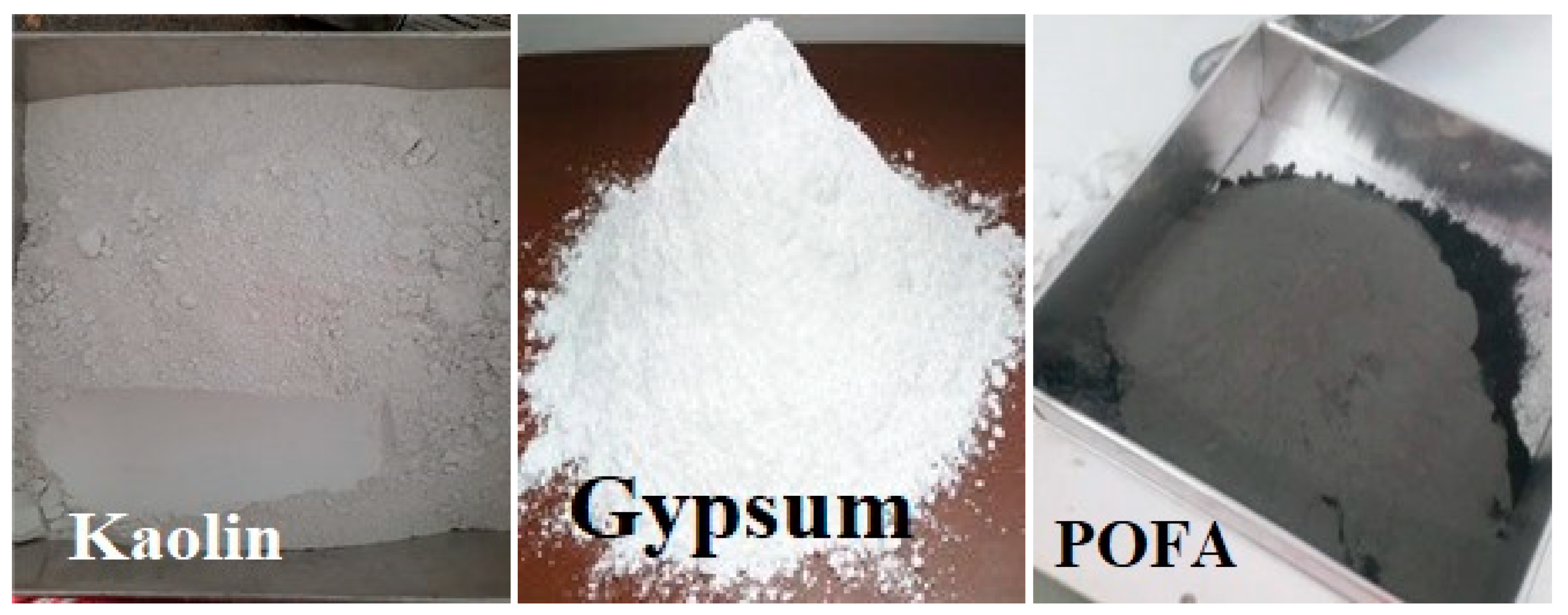


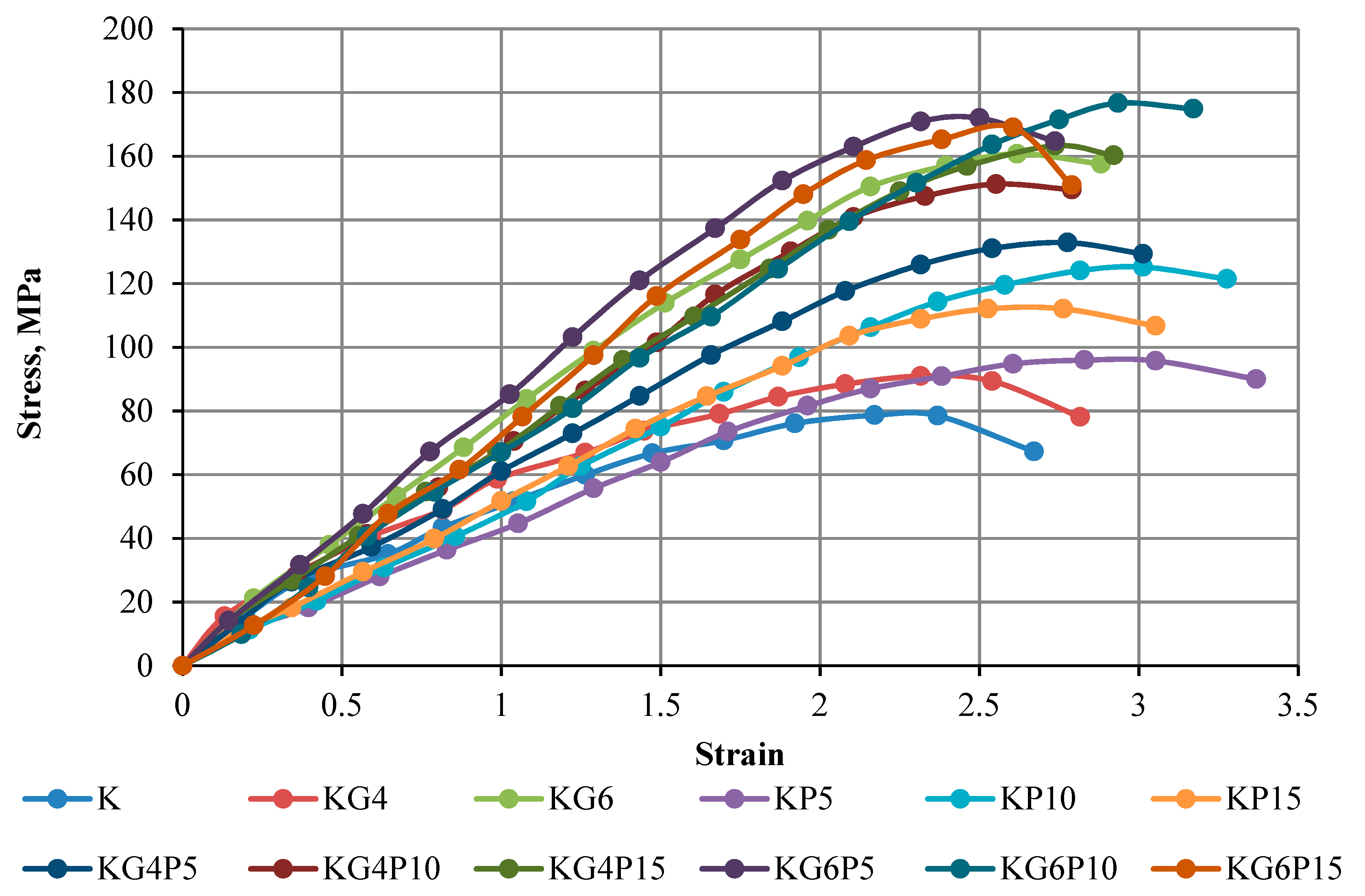
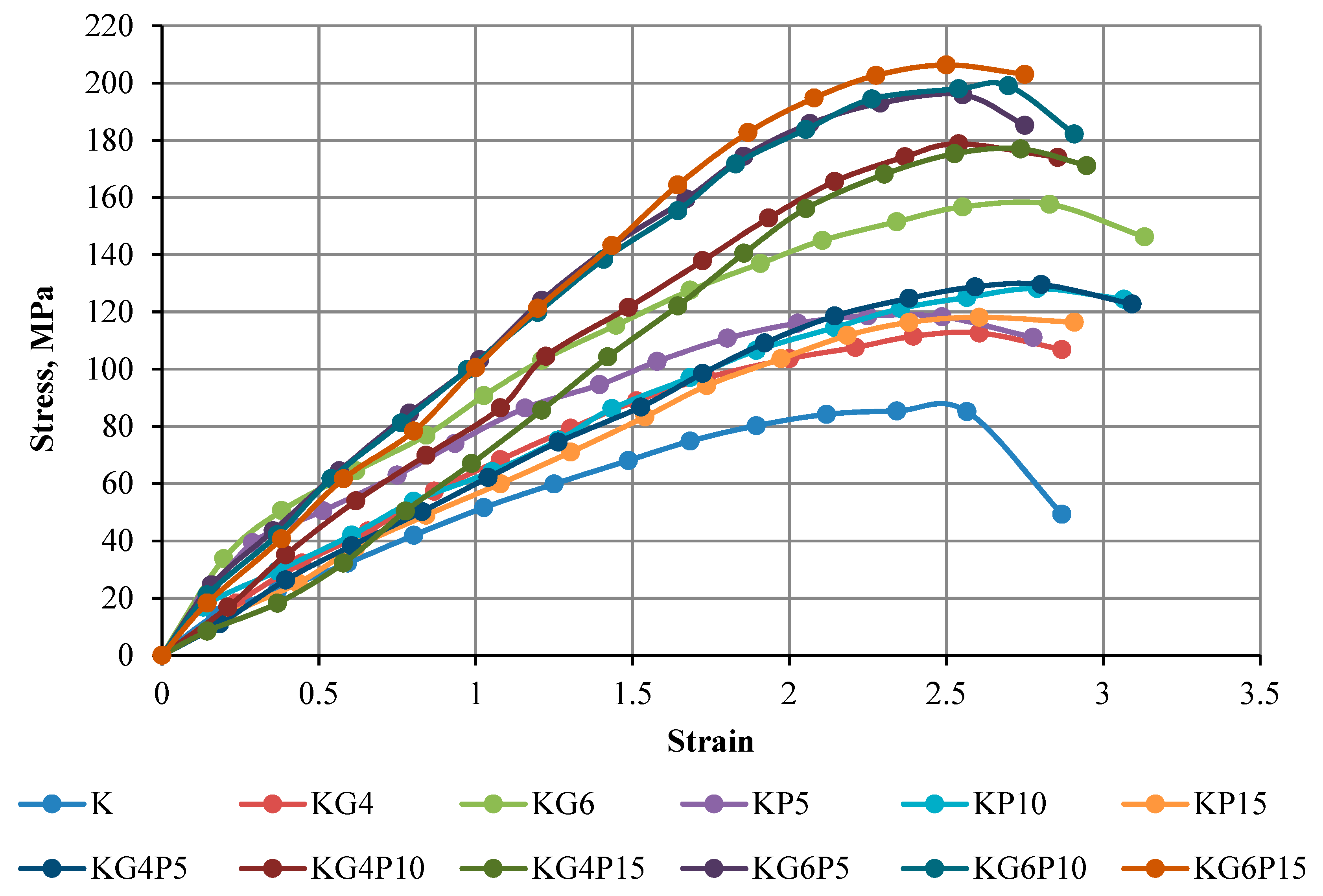
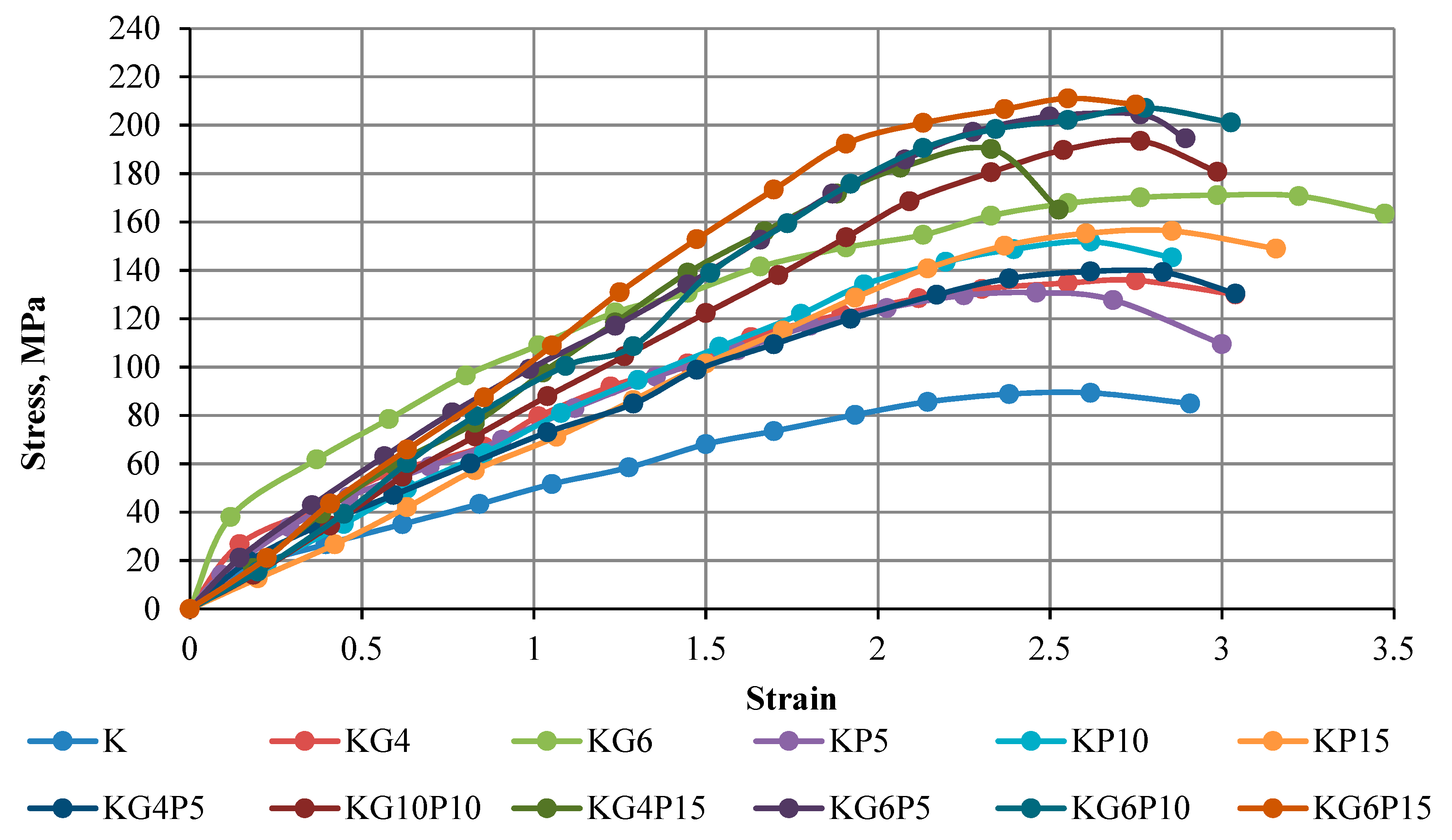

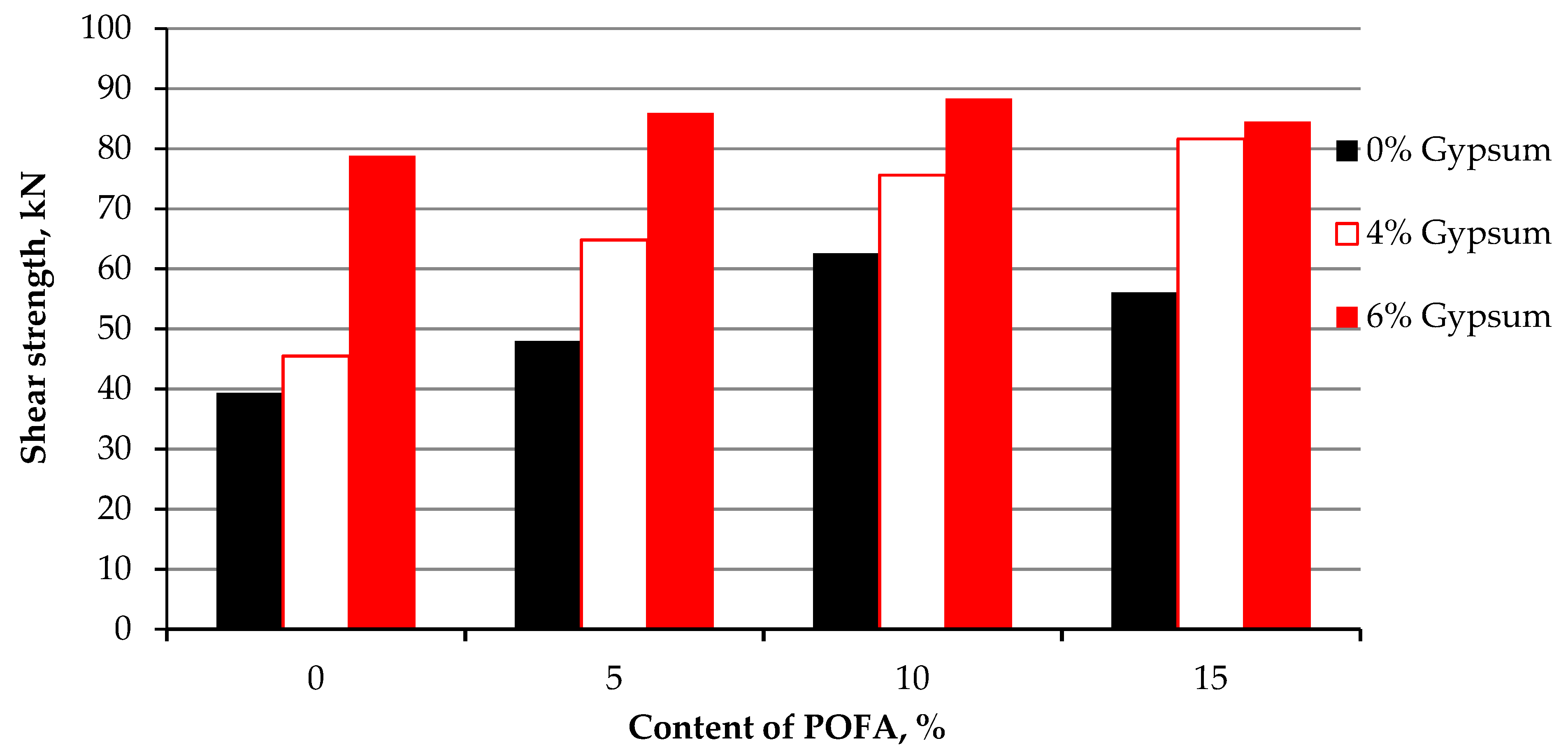
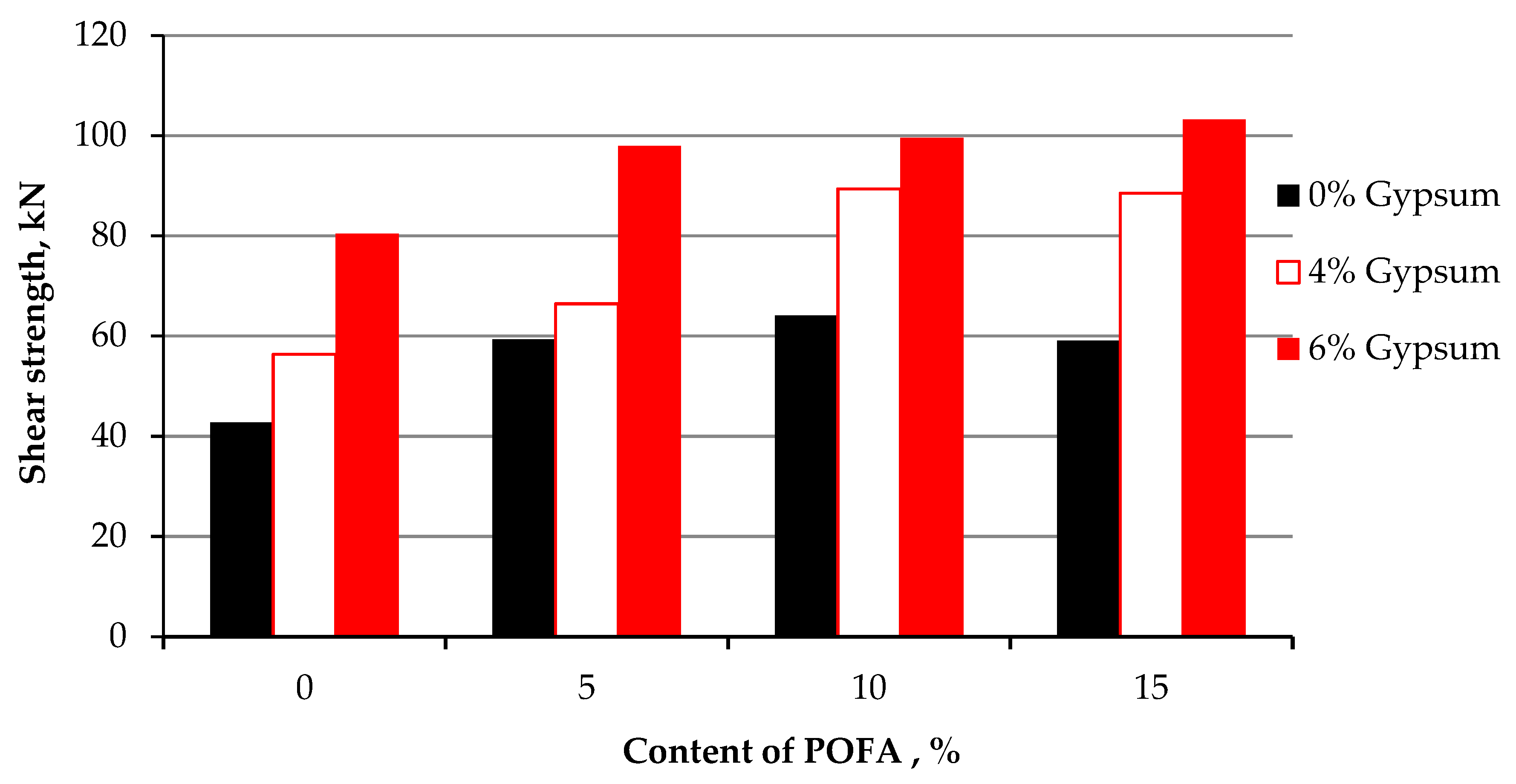
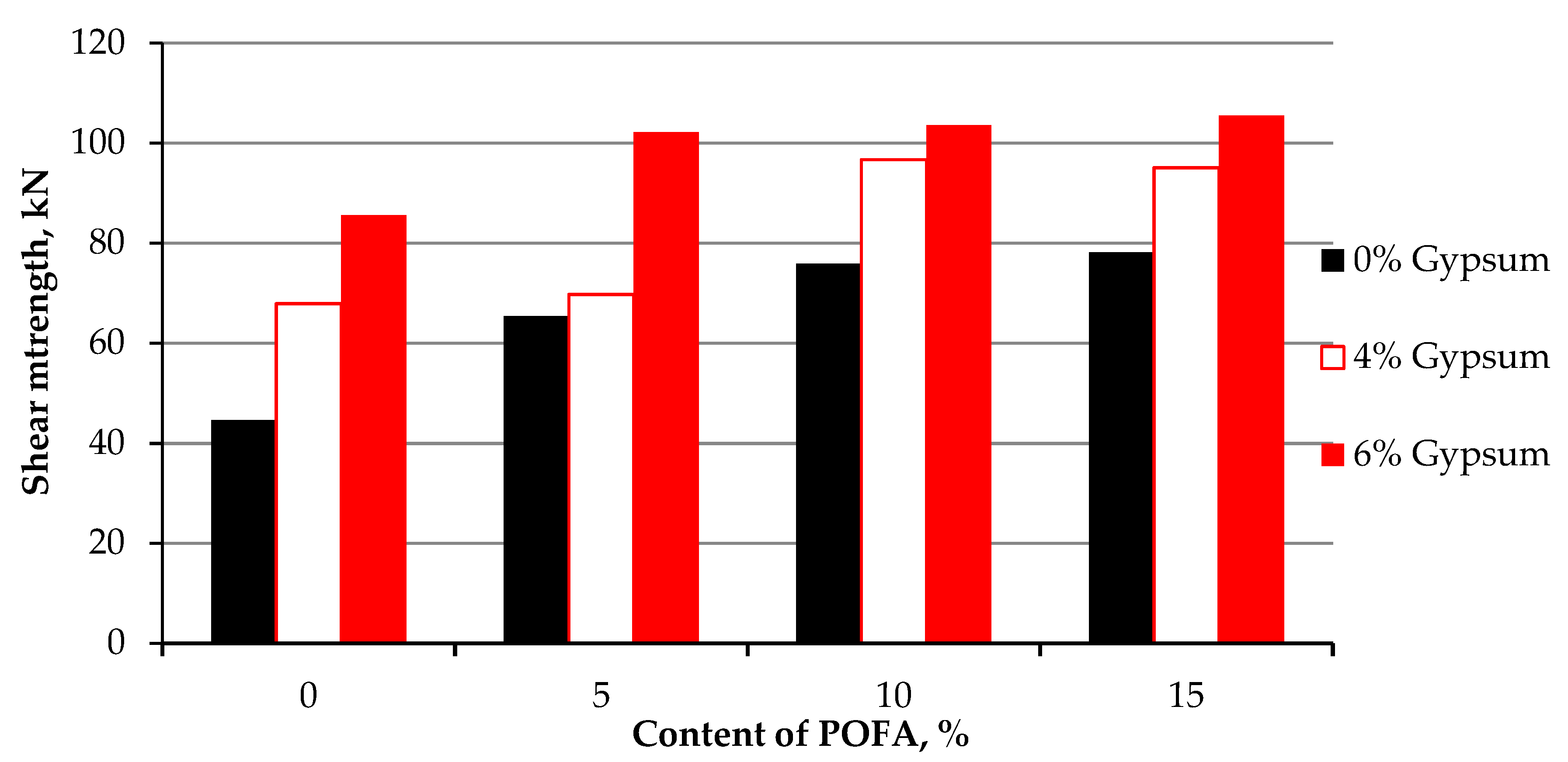
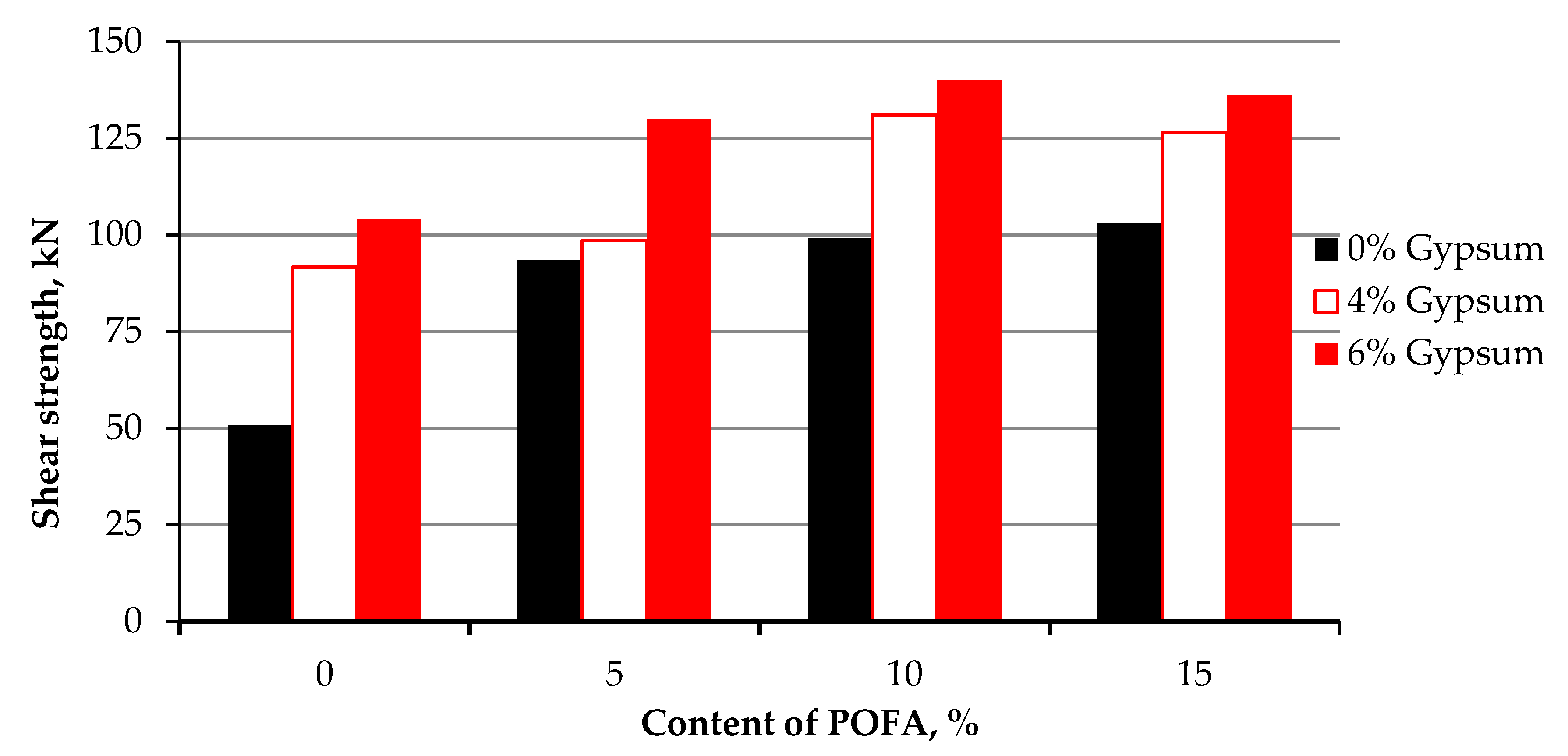
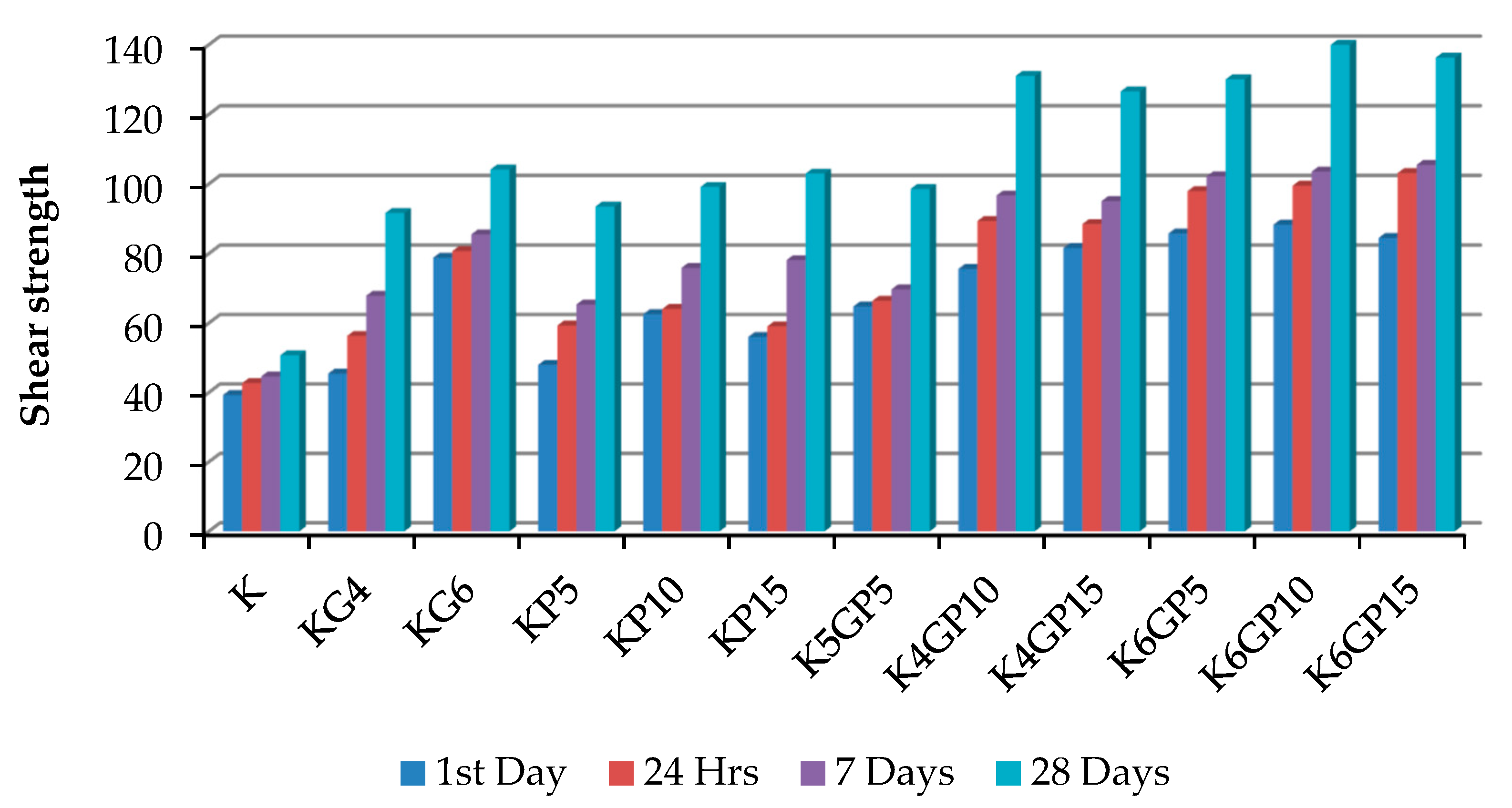

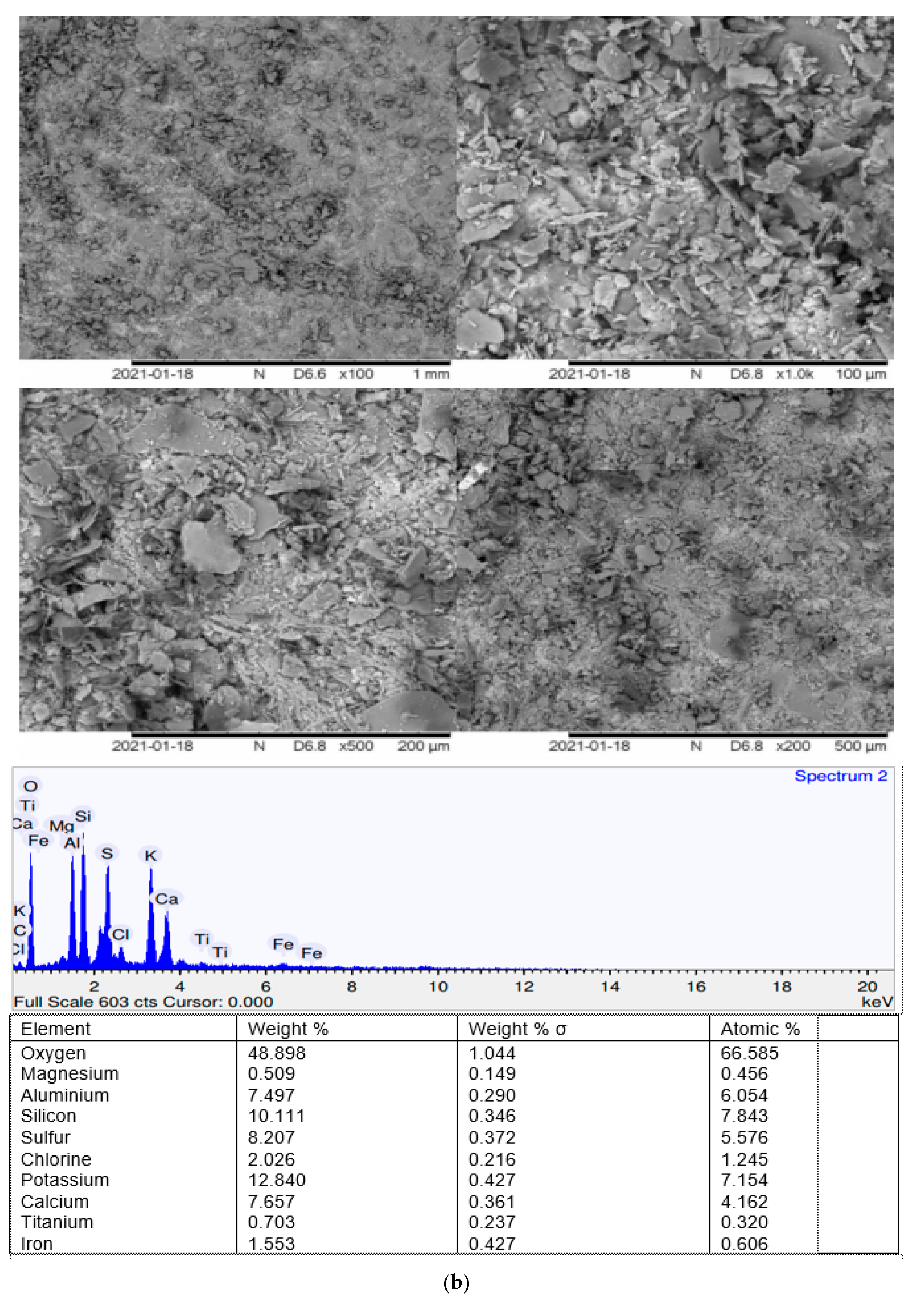
| Material/Chemical Compound Name | Chemical Formula | POFA | Gypsum | Kaolin |
|---|---|---|---|---|
| Alumina | Al2O3 | 1.33 | 1.25 | 17.1 |
| Ferrite | Fe2O3 | 8.71 | 0.422 | 0.626 |
| Silica | SiO2 | 35.9 | 4.97 | 73.5 |
| Lime | CaO | 13.2 | 47 | - |
| Potassium Oxide | K2O | 35.4 | 0.756 | 7.23 |
| Magnesia | MgO | 1.24 | 0.816 | 0.79 |
| Sulfur trioxide | SO3 | 1.39 | 44.6 | 0.102 |
| Titanium dioxide | TiO2 | - | - | 0.343 |
| Phosphorus Pentoxide | P2O5 | 1.91 | 0.164 | - |
| Manganese (II) oxide | MnO | 0.257 | - | - |
| Chlorine | Cl | 0.256 | - | - |
| Code | POFA | Gypsum | Kaolin | OMC % | Compacted Sample Mass (g) | ρ | Volume |
|---|---|---|---|---|---|---|---|
| K | 0 | 0 | 100 | 18 | 165.69 | 1.922 | |
| KG4 | 0 | 4 | 96 | 18.3 | 165.2075 | 1.917 | |
| KG6 | 0 | 6 | 94 | 18.8 | 166.4075 | 1.931 | |
| KP5 | 5 | 0 | 95 | 23 | 162.555 | 1.886 | |
| KP10 | 10 | 0 | 90 | 24 | 159.185 | 1.847 | |
| KP15 | 15 | 0 | 85 | 19.2 | 151.44 | 1.757 | 86.19 |
| KG4P5 | 5 | 4 | 91 | 19.8 | 159.5875 | 1.852 | |
| KG4P10 | 10 | 4 | 86 | 19.3 | 157.185 | 1.824 | |
| KG4P15 | 15 | 4 | 81 | 19.20 | 154.5225 | 1.793 | |
| KG6P5 | 5 | 6 | 89 | 19.10 | 161.235 | 1.871 | |
| KG6P10 | 10 | 6 | 84 | 19.20 | 157.58 | 1.828 | |
| KG6P15 | 15 | 6 | 79 | 19.00 | 157.625 | 1.829 |
| Sample | Variance | Standard Deviation | Sample | Variance | Standard Deviation |
|---|---|---|---|---|---|
| K | 0.017 | 0.67 | K4GP5 | 0.012 | 0.46 |
| KG4 | 0.009 | 0.37 | K4GP10 | 0.032 | 0.78 |
| KG6 | 0.014 | 0.060 | K4GP15 | 0.006 | 0.25 |
| KP5 | 0.022 | 0.87 | K6GP5 | 0.0032 | 0.124 |
| KP10 | 0.0063 | 0.25 | K6GP10 | 0.012 | 0.44 |
| KP15 | 0.0057 | 0.23 | K6GP15 | 0.002 | 0.033 |
| Sample | Variance | Standard Deviation | Sample | Variance | Standard Deviation |
|---|---|---|---|---|---|
| K | 0.025 | 0.82 | K4GP5 | 0.06 | 0.73 |
| KG4 | 0.0025 | 0.062 | K4GP10 | 0.09 | 1.55 |
| KG6 | 0.023 | 0.63 | K4GP15 | 0.009 | 0.19 |
| KP5 | 0.051 | 1.22 | K6GP5 | 0.04 | 0.46 |
| KP10 | 0.042 | 1.18 | K6GP10 | 0.007 | 0.28 |
| KP15 | 0.028 | 1.22 | K6GP15 | 0.005 | 0.49 |
| Sample | Variance | Standard Deviation | Sample | Variance | Standard Deviation |
|---|---|---|---|---|---|
| K | 0.038 | 0.68 | K4GP5 | 0.012 | 0.46 |
| KG4 | 0.071 | 0.71 | K4GP10 | 0.032 | 0.78 |
| KG6 | 0.0032 | 0.072 | K4GP15 | 0.006 | 0.25 |
| KP5 | 0.021 | 0.78 | K6GP5 | 0.0032 | 0.124 |
| KP10 | 0.017 | 0.23 | K6GP10 | 0.012 | 0.44 |
| KP15 | 0.017 | 0.28 | K6GP15 | 0.002 | 0.033 |
| Sample | Variance | Standard Deviation | Sample | Variance | Standard Deviation |
|---|---|---|---|---|---|
| K | 0.027 | 0.79 | K4GP5 | 0.009 | 0.67 |
| KG4 | 0.019 | 0.78 | K4GP10 | 0.024 | 0.78 |
| KG6 | 0.008 | 0.34 | K4GP15 | 0.017 | 0.099 |
| KP5 | 0.024 | 0.26 | K6GP5 | 0.0025 | 0.16 |
| KP10 | 0.003 | 0.89 | K6GP10 | 0.028 | 0.32 |
| KP15 | 0.006 | 0.44 | K6GP15 | 0.009 | 0.053 |
Publisher’s Note: MDPI stays neutral with regard to jurisdictional claims in published maps and institutional affiliations. |
© 2022 by the authors. Licensee MDPI, Basel, Switzerland. This article is an open access article distributed under the terms and conditions of the Creative Commons Attribution (CC BY) license (https://creativecommons.org/licenses/by/4.0/).
Share and Cite
Alhokabi, A.; Hasan, M.; Amran, M.; Fediuk, R.; Vatin, N.I.; Alshaeer, H. The Effect of POFA-Gypsum Binary Mixture Replacement on the Performance of Mechanical and Microstructural Properties Enhancements of Clays. Materials 2022, 15, 1532. https://doi.org/10.3390/ma15041532
Alhokabi A, Hasan M, Amran M, Fediuk R, Vatin NI, Alshaeer H. The Effect of POFA-Gypsum Binary Mixture Replacement on the Performance of Mechanical and Microstructural Properties Enhancements of Clays. Materials. 2022; 15(4):1532. https://doi.org/10.3390/ma15041532
Chicago/Turabian StyleAlhokabi, Abdulmajeed, Muzamir Hasan, Mugahed Amran, Roman Fediuk, Nikolai Ivanovich Vatin, and Honin Alshaeer. 2022. "The Effect of POFA-Gypsum Binary Mixture Replacement on the Performance of Mechanical and Microstructural Properties Enhancements of Clays" Materials 15, no. 4: 1532. https://doi.org/10.3390/ma15041532










